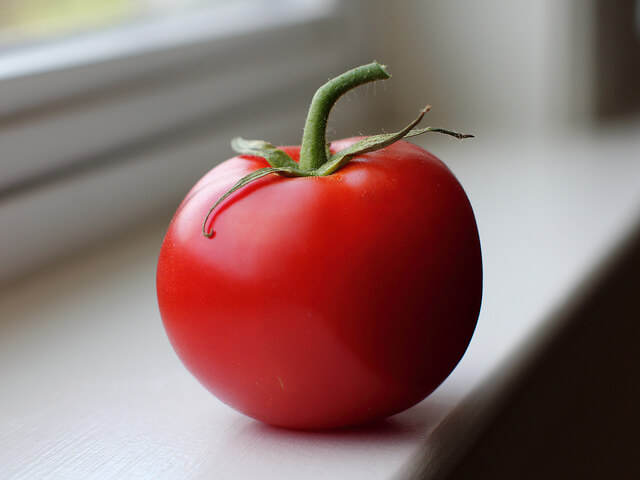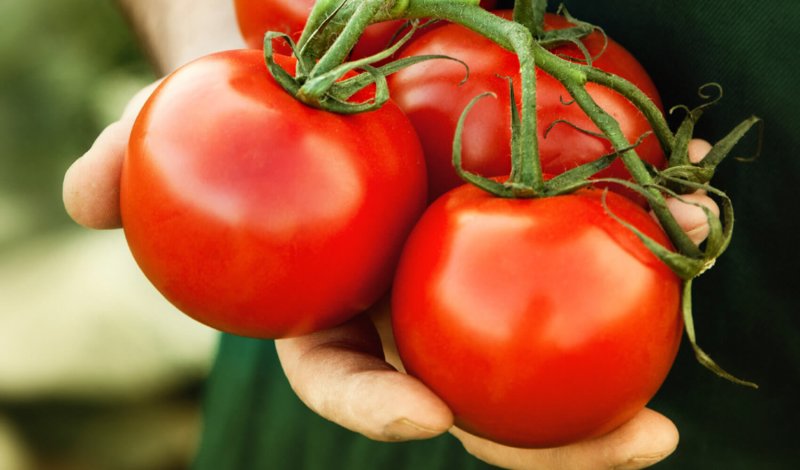Supermarket tomatoes have a sorry reputation for looking great but tasting…well, you know…like cardboard. It’s a shame, as tomatoes are very nutritious and a better-tasting tomato would encourage people, especially children, to eat them. Short of buying only heirloom tomatoes, which is not practical for everyone, what is the future of the tomato?
A tomato’s taste is heavily influenced by its genes. Conventional breeding has not been able to strike a good balance between taste and productivity, but that’s not the end of the story. Research efforts in genetic modification could bring back flavor in tomatoes, and a research study shows that these efforts are paying off: consumers in a taste test preferred genetically engineered tomatoes over conventional and even organic heirloom tomatoes.
How the supermarket tomato lost its flavor
The demise of the tomato’s flavor started about seventy years ago when growers noticed that some tomatoes turned red from green uniformly when they ripened. Back then, most tomatoes had shoulders—a raised area near the depression where the tomato attaches to the stem—that turned red slower than the rest of the tomato. The green shoulders made it difficult for farmers to tell when the tomato was ready to harvest, and shoppers did not like the look of them either.


So when the uniformly colored tomatoes randomly appeared, tomato breeders realized the potential. The effect that caused the green shoulders to disappear was due to a random genetic mutation, which was dubbed the “uniform ripening” trait. Farmers began selecting seeds from the uniformly red tomatoes and crossing them with other uniformly red tomatoes to create the visually perfect commercial tomatoes that we have today.
Because of the rudimentary understanding of genetics at that time, neither farmers nor researchers knew that the “uniform ripening” trait came with a trade off; it also disabled a gene in a tomato that regulates chlorophyll. Ann Powell, a plant scientist at the University of California, Davis, and her research group reported in a 2012 Science article that the chlorophyll concentrated in the green shoulders also increased the level of flavor-creating sugars for tomatoes. When the tomatoes’ green shoulders were bred out, so were the chlorophyll and extra sugars—and the tomato’s flavor. And this mutation was ubiquitous; when Powell and her colleagues examined 25 commercial tomato varieties from all over the world, they found the uniform ripening flavor reducing mutation in all of them.
“The mutation they describe in their paper is in literally 100 percent of modern breeds sold in grocery stores today,” said Harry Klee, a molecular geneticist at the University of Florida, who studies the chemistry and genetics of flavor in fruits and vegetables. “It’s a really good illustration of some of the problems with modern breeding of tomatoes.”
Tomato breeders didn’t stop at eliminating the green shoulders. As they continued to breed for more productive tomatoes and more rugged tomatoes that could withstand rough handling and long-distance shipping, the tomato breeders compromised the tomato’s flavor.
How biotchnology can help put the tomato’s flavor back
Genetics could play a big role in restoring tomato flavor, and some scientists have already found success. For example, by using a combination of modern genetic engineering methods and traditional breeding. Klee’s aims to introduce flavor-producing traits in a supermarket tomato without compromising the productive, robust traits that commercial growers love
After correlating people’s preferences with levels of sugars and particular flavor compounds in tomatoes, Klee has a pretty good idea of what the genetic makeup of an ideal commercial tomato should look like.
“I figure that with approximately five key genes we could very significantly improve flavor,” he said. Klee and his research team have already located three genes that control the production of key flavor compounds in tomatoes.

Other researchers are are targeting different genes to solve the flavor conundrum. The purple tomato, genetically engineered to produce anthocyanins, a group of antioxidants also found in blueberries, is further along in development. Researchers led by Cathie Martin, a plant biologist at the John Innes Centre in Norwich, UK, inserted a gene from a snapdragon flower that enables the tomato to produce anthocyanins. Anthocyanins were found to slow down the ripening process of the tomatoes, which enables them to develop full flavor while enjoying a longer shelf life.
“Our research has identified a new target for breeders to produce tomato varieties that are fuller in flavor, and so more appealing to consumers, and more valuable commercially due to increased shelf life,” has said Martin.
There are other attempts to introduce genes into tomatoes that enable them to produce flavor-enhancing compounds, such as a tomato genetically engineered to produce geraniol, a rose-smelling compound found in fruits and flowers, and a tomato genetically engineered to produce more flavonoids, another group of antioxidants, which also provide nutritional benefits. These two examples have undergone blind taste tests with untrained consumers, and in both cases, the consumers preferred the genetically engineered tomatoes over the conventional ones.
Resistance to GE tomatoes
But for all biotechnology has to offer, public anti-GMO sentiments, particularly in Europe, make it difficult for researchers to commercialize their tomatoes. Martin had to move his purple tomato research facility from the United Kingdom to Leamington, Canada, because of regulatory hurdles and public fear of GMOs in Europe.
“I can’t stress enough how enlightened the Canadian regulatory process towards these types of [genetically modified] foods is—it has truly been fantastic,” she said. “There is a fear of the unknown in the U.K. I think people here viewed genetically modified food as a new technology that wasn’t controlled enough to be able to say for certain that there were no risks associated with it.”
Because of the public resistance to GE, Klee plans on avoiding biotechnology altogether when he eventually produces a commercial version of his flavor-enhanced commercial, even though he is using genetically engineered tomatoes to test and confirm his findings. The reason: to avoid potential consumer backlash and the estimated $15 million needed to obtain regulatory approval for a genetically engineered tomato. Emily Willingham commented in Forbes:
Scientists can use modern techniques to ID exactly what to change in a tomato to make it sweeter and do it. But because of widespread misinformation, fearmongering, and politics, they cannot use these faster, modern approaches to actually produce the tomato. Instead, the modern techniques can serve only as a roadmap to confirm that a tomato produced by conventional means–i.e., more “naturally”–is exactly the same as the tomato they could develop and obtain with the modern techniques.
Researchers like Klee and Martin could succeed in producing a flavorful, commercial tomato but with current anti-GMO sentiments, it might be a long time before the fruits of their labor reach grocery stores.
XiaoZhi Lim is a freelance journalist and former GLP editor and writer.































